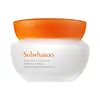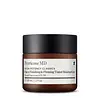What's inside
What's inside
 Key Ingredients
Key Ingredients

 Benefits
Benefits

 Concerns
Concerns

 Ingredients Side-by-side
Ingredients Side-by-side

Water
Skin ConditioningButylene Glycol
HumectantGlycerin
HumectantButylene Glycol Dicaprylate/Dicaprate
EmollientCetyl Ethylhexanoate
EmollientCaprylic/Capric Triglyceride
MaskingCyclopentasiloxane
EmollientDiisostearyl Malate
Emollient1,2-Hexanediol
Skin ConditioningGlyceryl Stearate
EmollientPolyglyceryl-3 Methylglucose Distearate
EmulsifyingCyclohexasiloxane
EmollientPEG-100 Stearate
Cetearyl Alcohol
EmollientHydroxyethyl Acrylate/Sodium Acryloyldimethyl Taurate Copolymer
Emulsion StabilisingPolyacrylate-13
Polymethylsilsesquioxane
Polyisobutene
Parfum
MaskingHoney
HumectantZiziphus Jujuba Fruit Extract
Skin ConditioningGlyceryl Caprylate
EmollientLimonene
PerfumingLycium Chinense Fruit Extract
AntioxidantSorbitan Isostearate
EmulsifyingPropanediol
SolventEthylhexylglycerin
Skin ConditioningDisodium EDTA
Adenosine
Skin ConditioningPolysorbate 20
EmulsifyingPueraria Lobata Root Extract
HumectantPolysorbate 60
EmulsifyingDioscorea Japonica Root Extract
Skin ConditioningCrataegus Pinnatifida Fruit Extract
Skin ConditioningLinalool
PerfumingNarcissus Tazetta Bulb Extract
AstringentPueraria Thunbergiana Flower/Leaf/Stem Extract
Skin ConditioningCitronellol
PerfumingDextrin
AbsorbentTheobroma Cacao Extract
Skin ConditioningMorus Alba Leaf Extract
Skin ConditioningCitral
PerfumingGeraniol
PerfumingRehmannia Glutinosa Root Extract
Skin ConditioningGlycyrrhiza Uralensis Root Extract
Skin ConditioningPaeonia Lactiflora Root Extract
Skin ConditioningLilium Candidum Bulb Extract
Skin ConditioningPolygonatum Odoratum Rhizome Extract
Skin ConditioningBenzyl Benzoate
AntimicrobialNelumbo Nucifera Flower Extract
Skin ConditioningHydrolyzed Soybean Extract
Skin ConditioningTocopherol
AntioxidantWater, Butylene Glycol, Glycerin, Butylene Glycol Dicaprylate/Dicaprate, Cetyl Ethylhexanoate, Caprylic/Capric Triglyceride, Cyclopentasiloxane, Diisostearyl Malate, 1,2-Hexanediol, Glyceryl Stearate, Polyglyceryl-3 Methylglucose Distearate, Cyclohexasiloxane, PEG-100 Stearate, Cetearyl Alcohol, Hydroxyethyl Acrylate/Sodium Acryloyldimethyl Taurate Copolymer, Polyacrylate-13, Polymethylsilsesquioxane, Polyisobutene, Parfum, Honey, Ziziphus Jujuba Fruit Extract, Glyceryl Caprylate, Limonene, Lycium Chinense Fruit Extract, Sorbitan Isostearate, Propanediol, Ethylhexylglycerin, Disodium EDTA, Adenosine, Polysorbate 20, Pueraria Lobata Root Extract, Polysorbate 60, Dioscorea Japonica Root Extract, Crataegus Pinnatifida Fruit Extract, Linalool, Narcissus Tazetta Bulb Extract, Pueraria Thunbergiana Flower/Leaf/Stem Extract, Citronellol, Dextrin, Theobroma Cacao Extract, Morus Alba Leaf Extract, Citral, Geraniol, Rehmannia Glutinosa Root Extract, Glycyrrhiza Uralensis Root Extract, Paeonia Lactiflora Root Extract, Lilium Candidum Bulb Extract, Polygonatum Odoratum Rhizome Extract, Benzyl Benzoate, Nelumbo Nucifera Flower Extract, Hydrolyzed Soybean Extract, Tocopherol
Titanium Dioxide 4.2%
Cosmetic ColorantWater
Skin ConditioningGlycerin
HumectantCyclopentasiloxane
EmollientDimethicone
EmollientPentylene Glycol
Skin ConditioningEthylhexyl Methoxycrylene
Skin ConditioningPolyester-8
Skin ConditioningPolyglyceryl-3 Polydimethylsiloxyethyl Dimethicone
Skin ConditioningHydroxyethyl Acrylate/Sodium Acryloyldimethyl Taurate Copolymer
Emulsion StabilisingBenzyl Alcohol
PerfumingAluminum Hydroxide
EmollientStearic Acid
CleansingCI 77491
Cosmetic ColorantCI 77492
Cosmetic ColorantCI 77499
Cosmetic ColorantDiethylhexyl Syringylidenemalonate
Skin ProtectingHydrogenated Lecithin
EmulsifyingCI 77891
Cosmetic ColorantIsohexadecane
EmollientBisabolol
MaskingMica
Cosmetic ColorantTetrahexyldecyl Ascorbate
AntioxidantPhenoxyethanol
PreservativeSilica Dimethyl Silylate
EmollientPolyester-1
Polysilicone-11
Polysorbate 60
EmulsifyingCaprylic/Capric Triglyceride
MaskingSodium Benzoate
MaskingPotassium Sorbate
PreservativeParfum
MaskingXanthan Gum
EmulsifyingHydrogenated Phosphatidylcholine
EmulsifyingCitronellol
PerfumingThioctic Acid
AntioxidantGeraniol
PerfumingAstaxanthin
Skin ConditioningHydroxycitronellal
PerfumingButylphenyl Methylpropional
PerfumingTitanium Dioxide 4.2%, Water, Glycerin, Cyclopentasiloxane, Dimethicone, Pentylene Glycol, Ethylhexyl Methoxycrylene, Polyester-8, Polyglyceryl-3 Polydimethylsiloxyethyl Dimethicone, Hydroxyethyl Acrylate/Sodium Acryloyldimethyl Taurate Copolymer, Benzyl Alcohol, Aluminum Hydroxide, Stearic Acid, CI 77491, CI 77492, CI 77499, Diethylhexyl Syringylidenemalonate, Hydrogenated Lecithin, CI 77891, Isohexadecane, Bisabolol, Mica, Tetrahexyldecyl Ascorbate, Phenoxyethanol, Silica Dimethyl Silylate, Polyester-1, Polysilicone-11, Polysorbate 60, Caprylic/Capric Triglyceride, Sodium Benzoate, Potassium Sorbate, Parfum, Xanthan Gum, Hydrogenated Phosphatidylcholine, Citronellol, Thioctic Acid, Geraniol, Astaxanthin, Hydroxycitronellal, Butylphenyl Methylpropional
Ingredients Explained
These ingredients are found in both products.
Ingredients higher up in an ingredient list are typically present in a larger amount.
This ingredient is an emollient, solvent, and texture enhancer. It is considered a skin-softener by helping the skin prevent moisture loss.
It helps thicken a product's formula and makes it easier to spread by dissolving clumping compounds.
Caprylic Triglyceride is made by combining glycerin with coconut oil, forming a clear liquid.
While there is an assumption Caprylic Triglyceride can clog pores due to it being derived from coconut oil, there is no research supporting this.
Learn more about Caprylic/Capric TriglycerideCitronellol is used to add fragrance/parfum to a product. It is often derived from plants such as roses. In fact, it can be found in many essential oils including geranium, lavender, neroli, and more. The scent of Citronellol is often described as "fresh, grassy, and citrus-like".
Since the Citronellol molecule is already unstable, Citronellol becomes irritating on the skin when exposed to air.
Citronellol is a modified terpene. Terpenes are unsaturated hydrocarbons found in plants. They make up the primary part of essential oils.
Citronellol is not able to be absorbed into deeper layers of the skin. It has low permeability,
Citronellol is also a natural insect repellent.
Learn more about CitronellolCyclopentasiloxane, or D5, is a silicone used to improve texture of products and trap moisture.
D5 is considered lightweight and volatile. Volatile means it evaporates quickly after application. Once evaporated, D5 leaves a thin barrier that helps keep skin hydrated.
It is also an emollient. Emollients help soften the skin and prevent water loss. Silicones create a silky texture in products. D5 helps other ingredients become more spreadable.
Studies show D5 is safe to use in skincare products. We recommend speaking with a skincare professional if you have concerns.
Learn more about CyclopentasiloxaneGeraniol is used to add fragrance/parfum to a product. It is the main component of citronellol. It is a monoterpenoid and an alcohol.
Monoterpenes are naturally found in many parts of different plants.
Geraniol can be found in many essential oils including Rose Oil and Citronella Oil. The scent of Geraniol is often described as "rose-like". Many foods also contain Geraniol for fruit flavoring.
Geraniol can irritate the skin when exposed to air. However, irritation depends on the ability of geraniol to penetrate into the skin. In general, geraniol is not able to penetrate skin easily.
Geraniol is colorless and has low water-solubility. However, it is soluble in common organic solvents.
Like citronellol, it is a natural insect repellent.
2,6-Octadien-1-ol, 3,7-dimethyl-, (2E)-
Learn more about GeraniolGlycerin is already naturally found in your skin. It helps moisturize and protect your skin.
A study from 2016 found glycerin to be more effective as a humectant than AHAs and hyaluronic acid.
As a humectant, it helps the skin stay hydrated by pulling moisture to your skin. The low molecular weight of glycerin allows it to pull moisture into the deeper layers of your skin.
Hydrated skin improves your skin barrier; Your skin barrier helps protect against irritants and bacteria.
Glycerin has also been found to have antimicrobial and antiviral properties. Due to these properties, glycerin is often used in wound and burn treatments.
In cosmetics, glycerin is usually derived from plants such as soybean or palm. However, it can also be sourced from animals, such as tallow or animal fat.
This ingredient is organic, colorless, odorless, and non-toxic.
Glycerin is the name for this ingredient in American English. British English uses Glycerol/Glycerine.
Learn more about GlycerinThis is a synthetic polymer. It helps improve the texture of products by adding thickness and gel-like feel.
It is also an emulsifer, meaning it prevents ingredients such as oil and water from separating. It also helps evenly disperse other ingredients.
Parfum is a catch-all term for an ingredient or more that is used to give a scent to products.
Also called "fragrance", this ingredient can be a blend of hundreds of chemicals or plant oils. This means every product with "fragrance" or "parfum" in the ingredients list is a different mixture.
For instance, Habanolide is a proprietary trade name for a specific aroma chemical. When used as a fragrance ingredient in cosmetics, most aroma chemicals fall under the broad labeling category of “FRAGRANCE” or “PARFUM” according to EU and US regulations.
The term 'parfum' or 'fragrance' is not regulated in many countries. In many cases, it is up to the brand to define this term.
For instance, many brands choose to label themselves as "fragrance-free" because they are not using synthetic fragrances. However, their products may still contain ingredients such as essential oils that are considered a fragrance by INCI standards.
One example is Calendula flower extract. Calendula is an essential oil that still imparts a scent or 'fragrance'.
Depending on the blend, the ingredients in the mixture can cause allergies and sensitivities on the skin. Some ingredients that are known EU allergens include linalool and citronellol.
Parfum can also be used to mask or cover an unpleasant scent.
The bottom line is: not all fragrances/parfum/ingredients are created equally. If you are worried about fragrances, we recommend taking a closer look at an ingredient. And of course, we always recommend speaking with a professional.
Learn more about ParfumPolysorbate 60 is used to help stabilize products. It is a surfactant and emulsifier. These properties help keep ingredients together in a product. Surfactants help reduce surface tension between ingredients with different states, such as liquids and solids. Emulsifiers help prevent oils and waters from separating.
Polysorbate 60 is sorbitol-based and created from the ethoxylation of sorbitan. Ethoxylation is a chemical reaction used to add ethylene oxide. Sorbitan is a the dehydrated version of sorbitol, a sugar found in fruits.
In this case, the 60 comes from reacting 60 units of ethylene oxide with sorbitan.
Polysorbates are commonly used in medicine and foods.
Learn more about Polysorbate 60Water. It's the most common cosmetic ingredient of all. You'll usually see it at the top of ingredient lists, meaning that it makes up the largest part of the product.
So why is it so popular? Water most often acts as a solvent - this means that it helps dissolve other ingredients into the formulation.
You'll also recognize water as that liquid we all need to stay alive. If you see this, drink a glass of water. Stay hydrated!
Learn more about Water